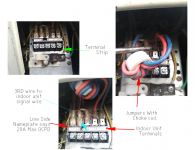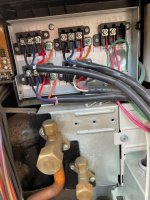hhsting
Senior Member
- Location
- Glen bunie, md, us
- Occupation
- Junior plan reviewer
I have indoor unit and an outdoor unit hvac. Outdoor unit is fed from panelboard circuit breaker B1.
Outdoor unit then has cable C1 that feeds indoor unit. So outdoor unit feeds indoor unit with cable C1.
What protects the cable C1 and how to size cable C1 or is cable C1 considered part of indoor and outdoor unit system and size is determined by manufacturer instruction?
Outdoor unit then has cable C1 that feeds indoor unit. So outdoor unit feeds indoor unit with cable C1.
What protects the cable C1 and how to size cable C1 or is cable C1 considered part of indoor and outdoor unit system and size is determined by manufacturer instruction?



